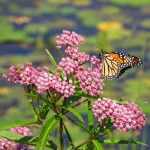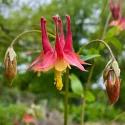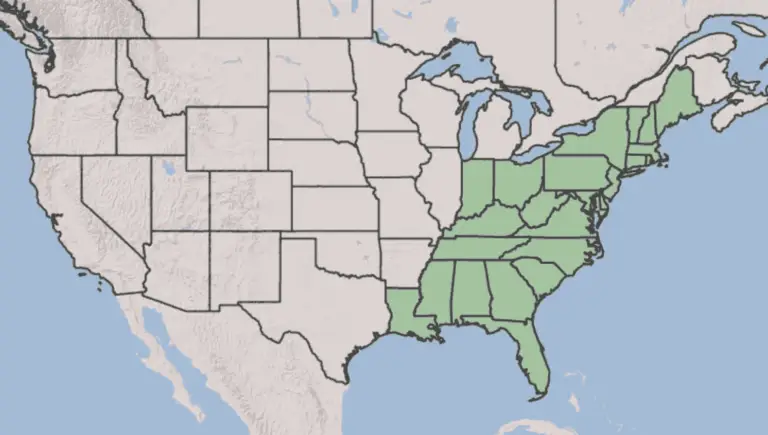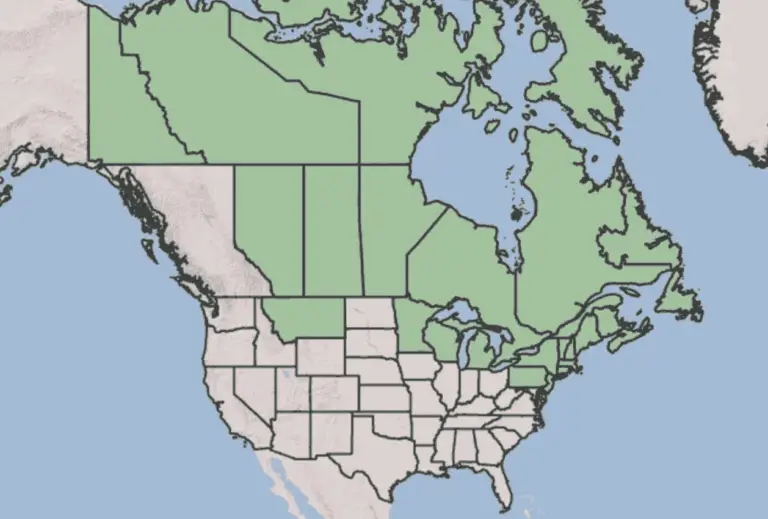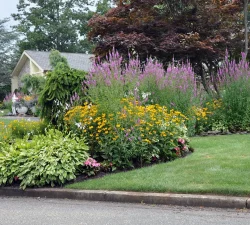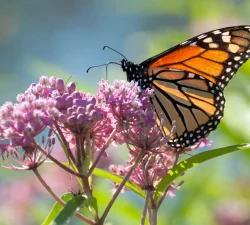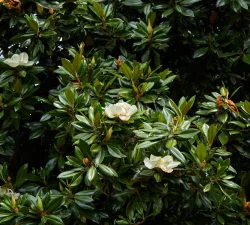Highlights
Mountain Laurel shrubs are stunning year-round, with glossy evergreen leaves and tiny, geometric flower clusters in the spring. Their branches twist to form sculptural arrangements. Growing Mountain Laurels is exceptionally easy: they require no fertilizer and are happy with rain after the first year. Spend a day planting a few and watch them return decades of fuss-free beauty.
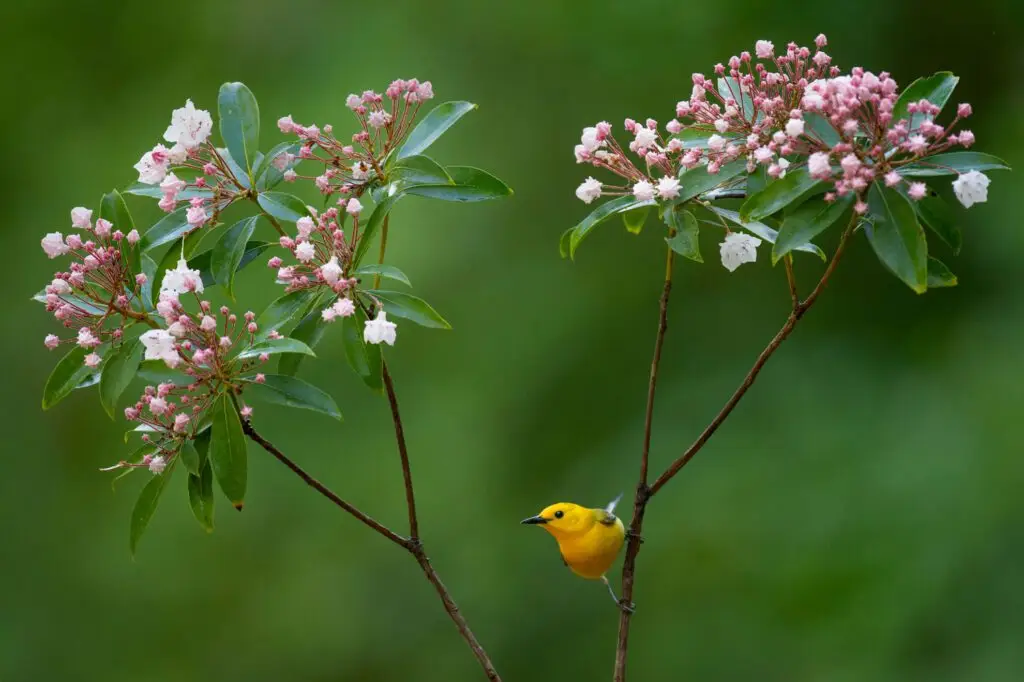
Dig Deeper
Explore the history, types, and where to plant native Mountain Laurels
Table of Contents
Mountain Laurel is a stunning native shrub
Mountain Laurel is a gorgeous native shrub that is easy to grow and returns decades of beauty. A native plant is a plant that has grown in an area for thousands of years. They have lived through every drought, storm, and crazy weather event and thrive with just rain.
Planting native plants like Mountain Laurel is important for lots of reasons, including:
- Native plants are the favorite food and homes for butterflies and birds
- Native plants have happily existed for thousands of years in their home area; they know our soil and seasons
- Planting native lets you be a lazy gardener! After native plants are established, they are happy with rain
These are just a few reasons why planting native plants keeps our yards and landscaping gorgeous with less work. (Did you know lawns take 2400% MORE TIME than native gardens?!)
Now let’s meet some native Mountain Laurels that will look amazing in your yard. First, let’s get one similarly-named plant out of the way.
Mountain Laurel vs. *Texas* Mountain Laurel
There are many species of mountain laurel native to America that fall into either the “Mountain Laurel” or “Texas Mountain Laurel” group. (If you’re worried about which is which or looking for a specific plant, writing down the Latin name of the type you want will be a huge help. See below for their Latin names!)
Both Mountain Laurel and Texas Mountain Laurel:
- Look fantastic in highly visible spaces, like against houses or front gardens
- Are evergreen: their leaves are there, year-round
- Like a wide range of light—from part sun to shade
- Perennials: they will come back year after year. Once you plant them and they are happily established, you can enjoy them in your yard for years to come.
- Low maintenance: no fertilizer or special needs are required for Mountain Laurel to thrive
Now, let’s meet these two ‘mountain laurels’ and find out what makes them different.
Types of Native Mountain Laurel
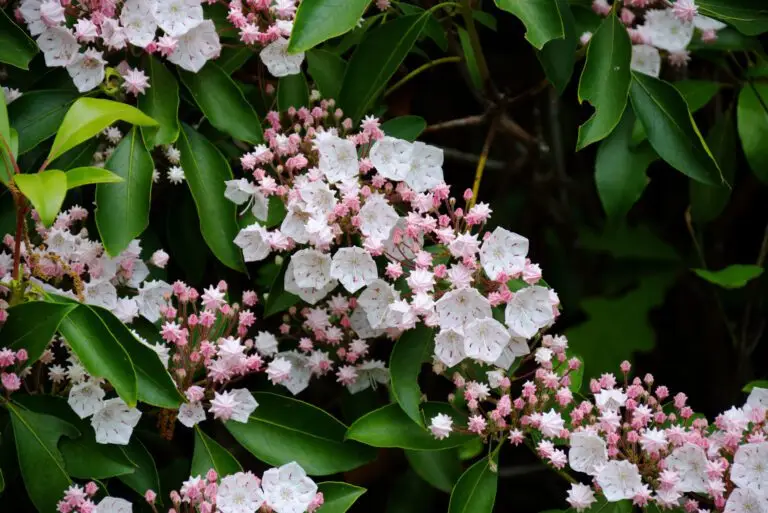
Mountain Laurel
(KALMIA)
The ‘Kalmia’ species of Mountain Laurels are native to the Eastern US. Shrubs in this species group have tiny flowers shaped like algebraic equations. You’ll know you’ve got the right plant if the Latin name starts with Kalmia. Read on to learn more about these plants!
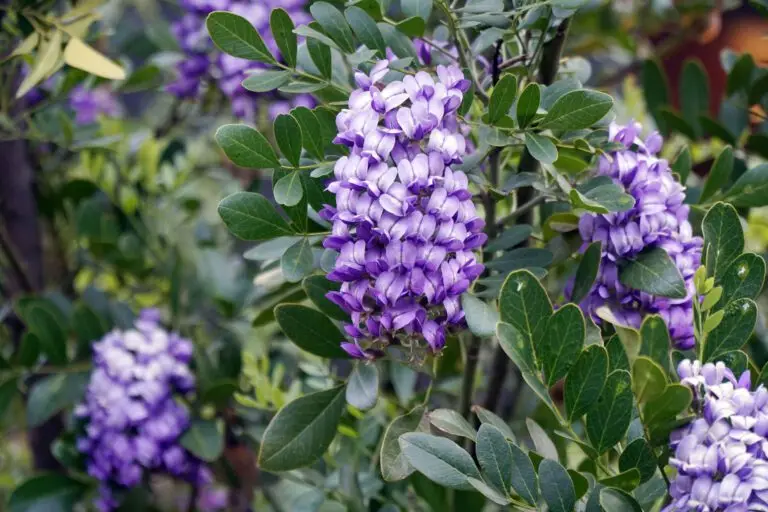
Texas Mountain Laurel
(Dermatophyllum secundiflorum)
Texas Mountain Laurel is native to Central Texas through to New Mexico. This species has flowers that smell glorious. Read about Texas Mountain Laurel and another plant profile.
In this article, we’ll focus on ‘Kalmia’
The Mountain Laurel (genus = ‘Kalmia‘) has lots of different native varieties and cultivars within it. A Kalmia Mountain Laurel covers itself in constellations of flowers in the late spring. After the flower display is over, its evergreen glossy leaves look great year-round.
Mountain Laurels are a perfect shrub to plant in highly visible areas—they look great all the time. If you live in the Northeast, Midwest, or Mid-Atlantic, plant a few Mountain Laurels when you can.
Since we’re talking about names, you may also be wondering…
What’s the difference between Mountain Laurels, Azaleas, and Rhododendrons?
All three of these shrubs get confused for good reason—they have a lot of similarities. We have a guide to all three aptly called, Azaleas vs Mountain Laurels vs. Rhododendrons—what’s the difference? for learning more.
And now, onto meeting some native Mountain Laurels!
Native Mountain Laurels
Here are Mountain Laurel species native to North America:
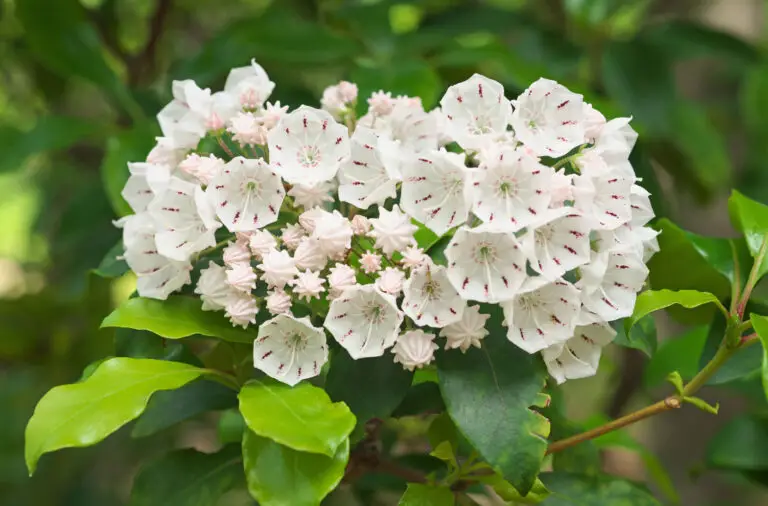
Mountain Laurel
(Kalmia latifolia)
Kalmia latifolia is a native Mountain Laurel (it also sometimes goes by the common name Spoonwood.) Its delicate white flowers are speckled with dark pink spots in their stunning geometric blooms. These native Mountain Laurels can get big (8 feet tall and wide) and grow slowly.
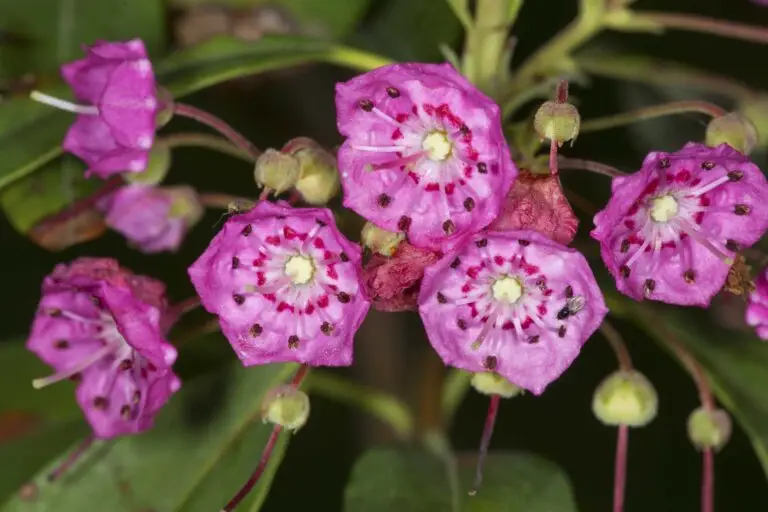
Swamp Mountain Laurel
(Kalmia polifolia)
Swamp Mountain Laurel (Kalmia polifolia) is another native Mountain Laurel that—as you can guess!—likes wetter environments. (You may also hear it called Bog Mountain Laurel.) Its flowers are pink or purple and on average the plant grows to be 2-3 feet tall and wide.
What are mountain laurels’ native ranges?
Swamp Mountain Laurel (Kalmia polifolia) is native from Maine upwards to the Canadian provinces. It thrives in cold climates!
There are also a few other native Mountain Laurel species that hang out in the Kalmia genus. These others can be found in the wild or at botanic gardens, but they are rarely seen in plant nurseries. These other species include:
- Sheep Laurel, native to the Northeast (Kalmia angustifolia)
- Mountain Myrtle, native to the Southeast (Kalmia buxifolia)
While you may not find these species in plant nurseries, you will probably find some Mountain Laurel cultivars, which are bred and created from these original native species.
You’ll now it’s a Mountain Laurel cultivar when you see a cheeky, marketing-speaky name in ‘single quotes,’ following its Latin name.
Mountain Laurel Cultivars
Here are just a few Mountain Laurel cultivars. Every year, more are created. (Wondering what a cultivar is? Read this short cultivar overview!) Each Mountain Laurel cultivar offers different flower colors, heights, and drought tolerances.
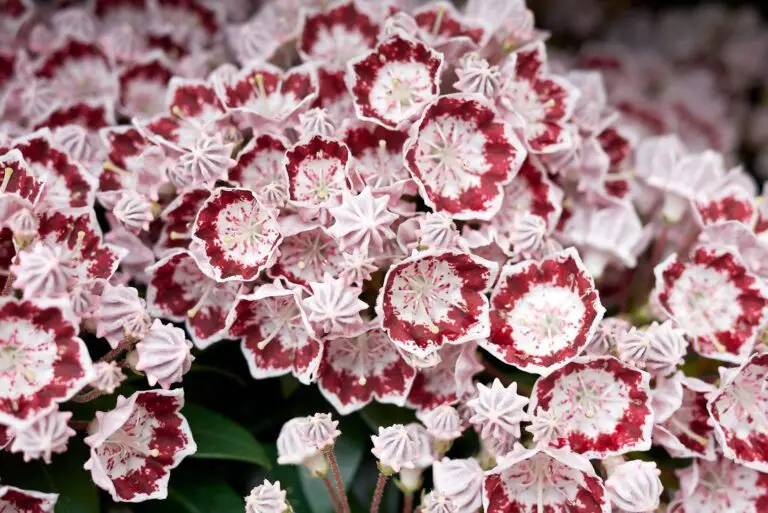
Mountain Laurel 'Minuet'
(Kalmia latifolia ‘Minuet’)
‘Minuet’ has a delicate stripe around its light-pink flowers. It has been cultivated to be short (3 feet tall and wide).
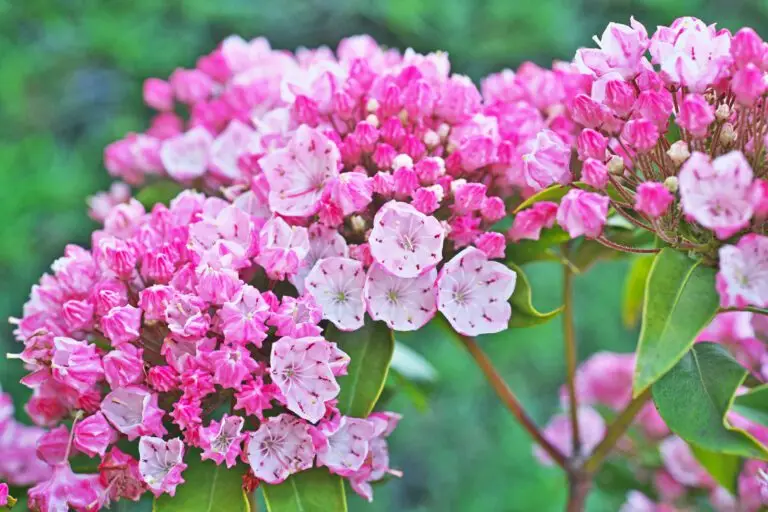
Mountain Laurel 'Tinkerbell'
(Kalmia latifolia ‘Tinkerbell’)
Kalmia latifolia ‘Tinkerbell’ has bright pink, Barbie-like flowers. It is also cultivated to be short (about 3 feet high and wide.)
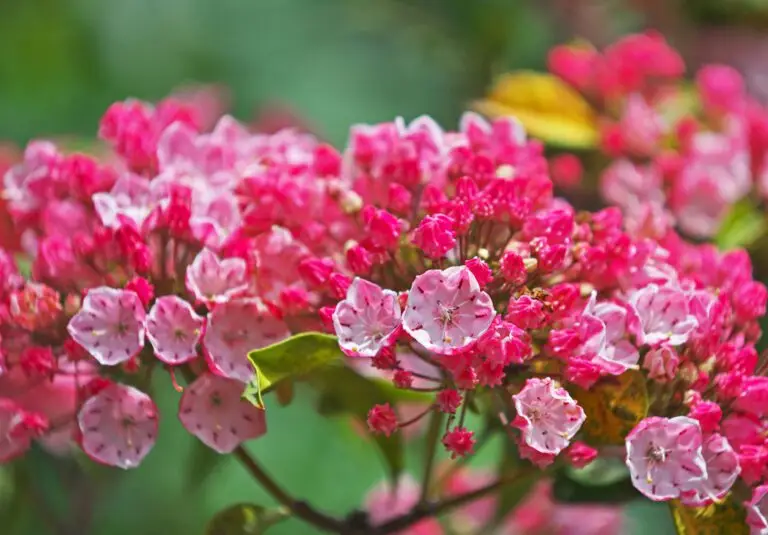
Mountain Laurel 'Olympic Fire'
(Kalmia latifolia ‘Olympic Fire’)
‘Olympic Fire’ is a larger shrub (5 feet tall and wide). It has hot pink buds that open into a lighter pink bloom.
Native vs. cultivar
Plant true native plants whenever possible. Cultivars (short for CULTivated VARieties) are selected and made by humans and do not offer the same benefits to bugs, birds, and animals that native plants do.
Now that you’ve met some native Mountain Laurels—you’re ready to plant some. Here’s the where and how, alongside some plant pairing inspiration:
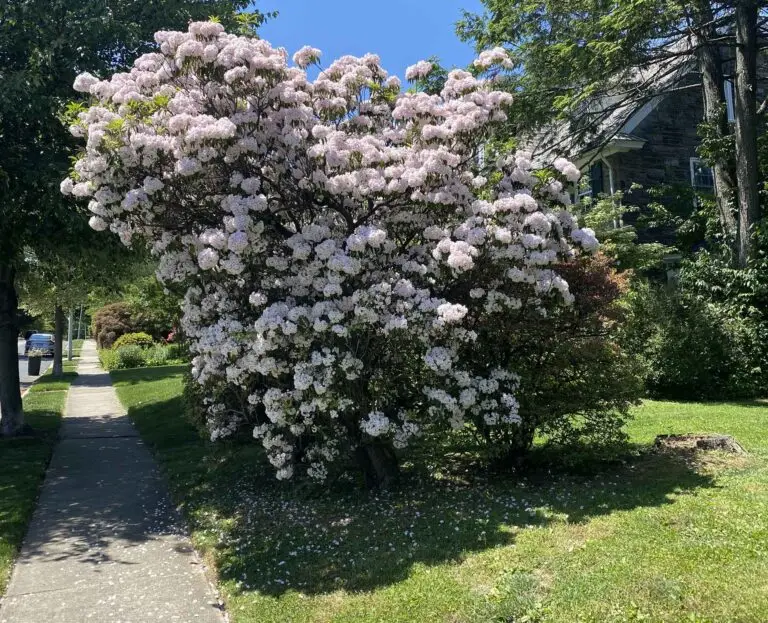
Where to plant Mountain Laurels
Plant Mountain Laurels in visible places, such as front yards, against foundations, and along driveways. They are a perfect shrub to replace boxwoods, which are non-native (honestly kind of boring!) shrubs. Mountain Laurels have glossy, evergreen leaves when they’re not in bloom, so they look great all the time.
How to grow Mountain Laurels
Mountain Laurels are ‘understory’ shrubs
Mountain laurels do well in a wide range of light—part sun to shade—because they are built to play nice next to taller trees. They are called “understory shrubs” because they are found underneath larger trees in nature.
What this means for planting is that they do well in lots of different situations, whether near a building or underneath an existing tree. The only type of light that will not work is full, blasting sun.
When do Mountain Laurels bloom?
On the east coast, Mountain Laurels bloom from the spring to the late spring. When Mountain Laurels are in bloom, they are knockouts. The Brooklyn Botanic Garden says it beautifully:
“In addition to being tolerant of shade, Kalmia latifolia produces exquisite clusters of delicate, fused-petal blossoms that resemble tiny origami rice bowls. When the buds burst open in May or June, the branches are virtually obscured by blooms. They can range from white to pink to deep rose and are distinctively tattooed with symmetrical maroon or purple dots or streaks.”
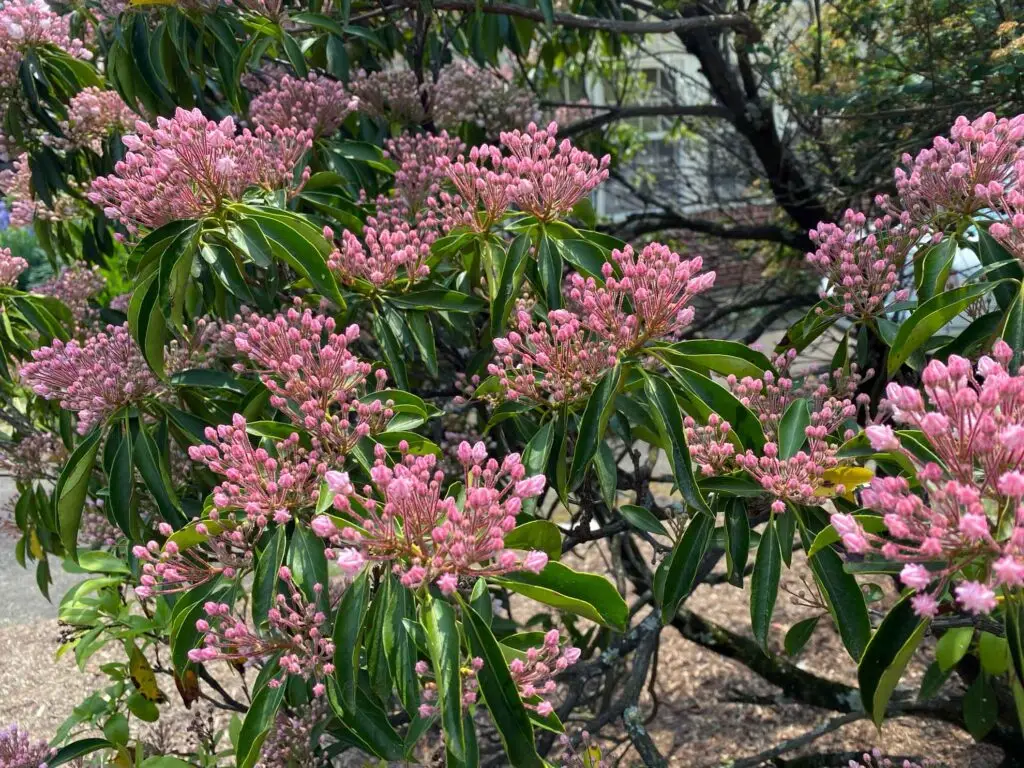
No eating Mountain Laurel—it’s poisonous!
All parts of Mountain Laurel—its leaves, flowers, etc—are poisonous if eaten. Eating Mountain Laurel can cause severe digestive upset, weakness, and paralysis. If you have young kids or animals that are prone to eating plants in the yard, this is probably not a good native plant for your garden.
This is also why…
Mountain Laurel is deer resistant!
Thanks in part to Mountain Laurel’s poisonous powers, this plant is deer-proof. Looking for other deer-unfriendly plants? Check out our deer-resistant native plants guide.
What to plant with Mountain Laurel
There are so many native plants that look great and pair nicely with Mountain Laurel, such as shrubs like native azaleas, Sweetshrubs, native rhododendrons, and Winterberries, Here are some stellar combinations for your garden.
Native shrubs to pair with Mountain Laurel
Native trees to pair with Mountain Laurel
Why not commit to planting some other flowering trees and put a garden in the sky? Here are some beautiful native trees like Pawpaws, Sweetbay Magnolias, and Tulip Poplars, and flowers like Golden Alexander to consider:
Native flowers to pair with Mountain Laurel
Looking to keep the pollinator party going? Here are some stellar flower combinations:
Mountain Laurel is a beautiful, easy-to-grow, evergreen shrub
To sum it up: Mountain Laurel is a stellar evergreen shrub that looks great planted in highly visible areas: front gardens, backyard edges, and property lines. Their dark green, glossy leaves look beautiful year-round. In the spring, they cover themselves in constellations of flowers. They are happy in a wide variety of light (shade, part shade, some sun.) Plant a few and enjoy them for decades to come. Happy planting!
Looking for more native plant resources? Our thematic guides and FAQs are your next stop:
Sources
- Harris, Marjorie. Botanica North America: The Illustrated Guide to Our Native Plants, Their Botany, History, and the Way They Have Shaped Our World. (2003), 175-176.
- Lorimer, Uli. The Northeast Native Plant Primer. (2022), 94.
- Brooklyn Botanic Garden, Mountain Laurel
